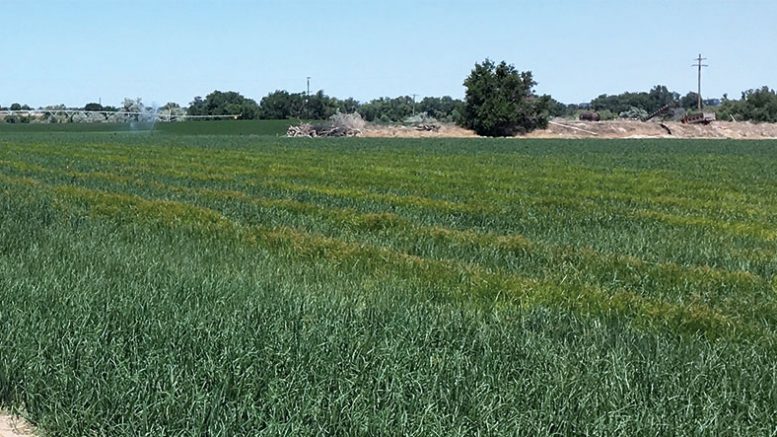By Bill Woodward, NovaSource
Even after decades of use, many onion growers continue to use the soil fumigant metam sodium as a reliable tool for suppressing weeds and diseases.
Yet recent field studies conducted by NovaSource reveal new findings that demonstrate the importance of soil preparation, soil moisture and precision placement. These insights are helping growers gain a greater understanding of how they can improve the outcome of their metam sodium applications.
Precision Placement
This more comprehensive awareness of both the product’s properties and the condition of the soil where it is being applied is enabling more than a dozen onion growers in the Pacific Northwest to witness significant performance improvement.
During the past two years, results from more than 20,000 post-application soil readings show that applicators can match metam sodium to the targeted pest in more efficient ways. These post-application fumigant level measurements were taken by NovaSource and cooperators at more than 100 fields. Samples represented a variety of soil types and growing conditions throughout eight states, including Washington, Oregon and Idaho. Readings were taken within hours and days of metam sodium application at different soil depths, using a photoionization detector (PID).
A longstanding common assumption has been that all fumigants behave generally the same way upon application. Many applicators have thought that metam sodium acted as a typical fumigant by moving widely, deeply and evenly throughout the soil profile.
“But it’s not true,” said Kyle Coleman, director of marketing and commercial development for NovaSource North America, who spearheaded the process of data gathering.
“We’re seeing that precision placement is key because metam sodium shows limited mobility in the soil due to its low vapor pressure,” Coleman added.
For years, onion growers have simply chemigated or shanked metam sodium, thinking the product would move evenly throughout the entire soil profile.
However, NovaSource field studies show that vertical and lateral movement is not happening in the ways that many growers have often assumed. Metam sodium movement was found to be limited to a vertical range of only 4 to 6 inches, and lateral movement was also observed to be inconsistent in dry, compacted soil conditions.
Proper Preparation
Another insight from the studies reveals the importance of moisture. Metam sodium has been shown to move farther in soil that is already pre-irrigated, so an increasing number of growers are finding it beneficial to properly prepare the soil in advance of application.
Ideally, the soil moisture level should be 80 percent throughout the targeted soil profile, while maintaining that moisture level for up to 30 days in advance of the day you apply the product, if possible. This is critical to prevent surface drying while initiating other activity below the soil surface.
Moisture in the soil activates respiration, and respiring pests are easier to control, according to Steven Fennimore, extension weed scientist at the University of California Davis.
“Actively respiring seeds, weeds and diseases are more susceptible to fumigants,” Fennimore said. “Dry seeds are hard to kill.”
In the NovaSource field tests, average post-application metam sodium readings at 80 percent moisture were higher and lasted longer than in 50 percent soil moisture – further evidence that the “use label” provides excellent guidance for both maximizing results and for adhering to excellent stewardship standards.
Upon learning about the importance of soil moisture in both facilitating metam sodium movement in soil and activating pest respiration, onion growers at more than a dozen Pacific Northwest locations began experimenting with soil moisture levels.
“These growers saw significant changes in their onion fields as a result of pre-watering the soil for up to six weeks before fumigating,” said Tad Comer, a regional account manager for NovaSource in Idaho.
Comer explained that several of the growers had been in a three-year corn-wheat-onion rotation and were besieged by yellow nutsedge following the harvest of their small grains.
“The ones who pre-conditioned the weeds for up to six weeks by keeping the soil moist found the greatest success following their fumigant application,” Comer said. “The fumigant did a better job of suppressing the yellow nutsedge that can cause problems with onion seedlings.”
He added that applicators who also shanked their metam sodium at a shallower depth than they had been doing previously – applying the product at depths between 6 and 7 inches versus 8 to 10 inches – observed additional favorable results.
Best Conditions
Overall, the findings in the NovaSource studies have validated that the ideal conditions for planting are often the best conditions for fumigating.
Every application situation is unique. When you know your target pest and its depth in the soil, the most effective use of metam sodium is driven by three things, according to Coleman:
- Prepare the soil the same way you’d create ideal growing conditions, by making sure it’s mixed, mellow and non-compacted.
- Moisten the soil for up to 30 days. Remember, you’re both conditioning the soil and enabling the pest to respirate to maximize efficacy.
- Place the product exactly where you need it to work by using the most effective application technique.
“After studying metam sodium movement at each location, every single cooperator did something a little different the next time they applied the product,” Coleman said.
Whether it was the way they prepped their fields, or the way they applied metam sodium or the sealing practices, every one of them changed something to improve their application method.
“I urge you to see things differently and to consider new ways to prepare and moisten your soil to enhance the efficacy of metam sodium,” Coleman said. “Two years in trenches and 20,000 post-application readings have shown our cooperators that metam sodium does the job when applied within inches of the pest after proper field preparation. Armed with this information, you’ll know exactly where to place your metam sodium to be most effective.”

